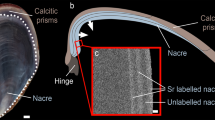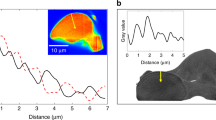Abstract
It was assumed for a long time that organisms produce minerals directly from a saturated solution. A few exceptions were known, including the well documented mineralized teeth of the chiton. In 1997 it was demon-strated that sea urchin larvae form their calcitic spicules by first depositing a highly unstable mineral phase called amorphous calcium carbonate. This strategy has since been shown to be used by animals from other phyla and for both aragonite and calcite. Recent evidence shows that vertebrate bone mineral may also be formed via a precursor phase of amorphous calcium carbonate. This strategy thus appears to be widespread. The challenge now is to understand the mechanisms by which these unstable phases are initially formed, how they are temporarily stabilized and how they are destabilized and transform into a crystalline mature product.
Similar content being viewed by others
References
Weiner S, Sagi I, Addadi L. Choosing the path less traveled. Science, 2005, 309: 1027–1028
Ehrenberg C G. Phosphosaures kalk in den zähnen und kieselerde in dem panzer von infusorein. Ann Phys Lpz, 1834, 32: 574–576
Minchin E A. Sponge-spicules. Summary of present knowledge. Ergebn Fortschr Zoologie, 1909, 2: 171–274
Towe K M, Lowenstam H A. Ultrastructure and development of iron mineralization in the radular teeth of Cryptochiton stelleri (Mollusca). Journal of Ultrastructure Research, 1967, 17: 1–13
Lowenstam H A. Magnetite in denticle capping in recent chitons (Polyplacophera). Geological Society of America Bulletin, 1962, 73: 435–438
Kirschvink J L, Lowenstam H A. Mineralization and magnetization of chiton teeth: paleomagnetic, sedimentologic, and biologic implications of organic magnetite. Earth and Planetary Science Letters, 1979, 44: 193–204
Brecevic L J, Furedi-Milhofer H. Precipitation of calcium phosphates from electrolyte solutions. II. The formation and transformation of precipitates. Calcified Tissue Research, 1972, 10: 82–90
Glimcher M J. Recent studies of the mineral phase in bone and its possible linkage to the organic matrix by protein-bound phosphate bonds. Philosophical Transactions of the Royal Society B, 1984, B304: 479–508
Grynpas M D, Bonar L C, Glimcher M J. Failure to detect an amorphous calcium-phosphate solid phase in bone mineral: a radial distribution function study. Calcified Tissue International, 1984, 36: 291–301
Brown W E, Chow L C. Chemical properties of bone mineral. Annual Review of Materials Science, 1976, 6: 213–236
Brecevic L, Nielsen A E. Solubility of amorphous calcium carbonate. Journal of Crystal Growth, 1989, 98: 504–510
Clarkson J R, Price T J, Adams C J. Role of metastable phases in the spontaneous precipitation of calcium carbonate. Journal of the Chemical Society, Faraday Transactions, 1992, 88: 243–249
Addadi L, Raz S, Weiner S. Taking advantage of disorder: amorphous calcium carbonate and its roles in biomineralization. Advanced Materials, 2003, 15: 959–970
Lowenstam H A, Weiner S. On Biomineralization. New York: Oxford University Press, 1989
Golubic S, Campbell S E. Biologically-formed aragonite concretions in marine Rivularia. In: Monty C L V. Phanerozoic Stromatolites. New York: Springer-Verlag, 1980, 209–229
Lowenstam H A. Mineralization processes in monerans and vprotoctists. In: Leadbeater B S C, Riding R. Biomineralization of Lower Plants and Animals. Oxford: Clarendon Press, 1986, 1–17
Mann S. Structure, morphology, and crystal growth of bacterial magnetite. In: Kirschvink J L, Jones D S, MacFadden B J. Magnetite Biomineralization and Magnetoreception in Organisms. New York: Plenum Press, 1985, 311–332
Hallberg R O. Iron and zinc sulfides formed in a continuous culture of sulfate reducing bacteria. Neues Jahrbuch fur Mineralogie-Monatshefte, 1972, 481–500
Lowenstam H A, Weiner S. Transformation of amorphous calcium phosphate to crystalline dahllite in the radular teeth of chitons. Science, 1985, 227: 51–53
Kessel E. Über die Schale von Viviparus viviparus L. und Viviparus fasciatus Mull. Z Morphol Okol Tiere, 1933, 27: 9–198
Nelson D G A, Wood D J, Barry J C. The structure of (100) defects in carbonated apatite crystallites: a high resolution electron microscope study. Ultramicroscopy, 1986, 19: 253–266
Beniash E, Aizenberg J, Addadi L, et al. Amorphous calcium carbonate transforms into calcite during sea-urchin larval spicule growth. Proceedings of the Royal Society of London, Series B, 1997, 264: 461–465
Berman A, Hanson J, Leiserowitz L, et al. Biological control of crystal texture: Awidespread strategy for adapting crystal properties to function. Science, 1993, 259: 776–779
Gueta R, Natan A, Addadi L, et al. Local atomic order and infrared spectra of biogenic calcite. Angewandte Chemie — International Edition, 2006, 46: 291–294
Raz S, Hamilton P C, Wilt F H, et al. The transient phase of amorphous calcium carbonate in sea urchin larval spicules: The involvement of proteins and magnesium ions in its formation and stabilization. Advanced Functional Materials, 2003, 13: 480–486
Politi Y, Levi-Kalisman Y, Raz S, et al. Strucutural characterization of the transient calcium carbonate amorphous precursor phase in sea urchin embryos. Advanced Functional Materials, 2006, 16: 1289–1298
Politi Y, Arad T, Klein E, et al. Sea urchin spine calcite forms via a transient amorphous calcium carbonate phase. Science, 2004, 306: 1161–1164
Politi Y, Metzler R A, Abrecht M, et al. Transformation mechanism of amorphous calcium carbonate into calcite in the sea urchin larval spicule. Proceedings of the National Academy of Sciences of the United States of America, 2008, 105: 17362–17366
Ma Y, Weiner S, Addadi L. Mineral deposition and crystal growth in the continuously forming teeth of sea urchins. Advanced Functional Materials, 2007, 17: 2693–2700
Marxen J C, Becker W, Finke D, et al. Early mineralization in Biomphalaria glabrata: microscopic and structural results. Journal of Molluscan Studies, 2003, 69: 113–121
Hasse B, Ehrenberg H, Marxen J, et al. Calcium carbonate modification in the mineralized shell of the freshwater snail Biomphalaria glabrata. Chemistry — A European Journal, 2000, 6: 3679–3685
Weiss I M, Tuross N, Addadi L, et al. Mollusk larval shell formation: amorphous calcium carbonate is a precursor for aragonite. Journal of Experimental Zoology, 2002, 293: 478–491
Nassif N, Pinna N, Gehrke N, et al. Amorphous layer around aragonite platelets in nacre. Proceedings of the National Academy of Sciences of the United States of America, 2005, 102: 12563–12655
Chave K E. Aspects of the biogeochemistry of magnesium I. Calcareous marine organisms. Journal of Geology, 1954, 62: 266–283
Vinogradov A P. The Elementary Chemical Composition of Marine Organisms. Sears Foundation for Marine Research II. New Haven: Yale University Press, 1953
Dillaman R, Hequembourg S, Gay M. Early pattern of calcification in the dorsal carapace of the blue crab, Callinectes sapidus. Journal of Morphology, 2005, 263: 356–374
Levi-Kalisman Y, Raz S, Weiner S, et al. X-Ray absorption spectroscopy studies on the structure of a biogenic “amorphous” calcium carbonate phase. Journal of the Chemical Society — Dalton Transactions, 2000, 3977–3982
Darwin C. The Formation of Vegetable Mould, Through the Action of Worms, with Observations on Their Habits. London: John Murray, 1881
Lee M R, Hodson M E, Langworthy G N. Crystallization of calcite from amorphous calcium carbonate: earthworms show the way. Mineralogical Magazine, 2008, 71: 257–261
Gago-Duport L, Briones M J I, Rodriguez J B, et al. Amorphous calcium carbonate biomineralization in the earthworm’s calciferous gland: pathways to the formation of crystalline phases. Journal of Structural Biology, 2008, 162: 422–435
Meibom A, Cuif J P, Hillion F, et al. Distribution of magnesium in a coral skeleton. Journal of Geophysical Research, 2004, 31: L23306–23310
Crane N J, Popescu V, Morris M D, et al. Raman spectroscopic evidence for octacalcium phosphate and other mineral species deposited during intramembraneous mineralization. Bone, 2006, 39: 431–433
Mahamid J, Sharir A, Addadi L, et al. Amorphous calcium phosphate is a major component of the forming fin bones of zebrafish: indications for an amorphous precursor phase. Proceedings of the National Academy of Sciences of the United States of America, 2008, 105: 12748–12753
Sone E D, Weiner S, Addadi L. Biomineralization of limpet teeth: A cryo-TEM study of the organic matrix and the onset of mineral deposition. Journal of Structural Biology, 2007, 158: 428–444
Author information
Authors and Affiliations
Corresponding author
Rights and permissions
About this article
Cite this article
Weiner, S., Mahamid, J., Politi, Y. et al. Overview of the amorphous precursor phase strategy in biomineralization. Front. Mater. Sci. China 3, 104–108 (2009). https://doi.org/10.1007/s11706-009-0036-x
Received:
Accepted:
Published:
Issue Date:
DOI: https://doi.org/10.1007/s11706-009-0036-x




